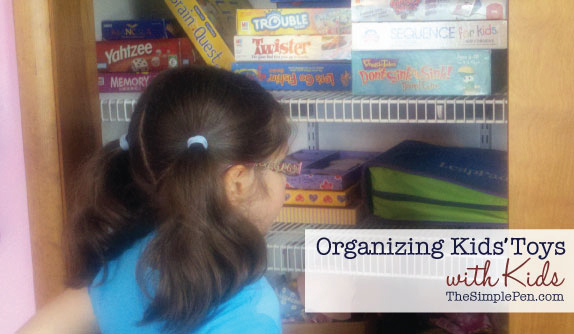Okay. ‘Fess up. You’ve snuck out at least one of your kid’s old toys when they weren’t looking. You grabbed it, stuffed it in the trash or donation bag, and sent it on its way without it being missed.
You have, right?
I used to do that too. It’s much easier than fighting the but-I’m-still-playing-with-it battle, especially when you KNOW that toy’s been sitting for months. There’s a layer of dust on it for heaven’s sake!
Now that Emma is ten, I’ve changed my strategy. No more sneaking out toys. No more solo decluttering by Mom. Emma and I have been working our way through her toys one area at a time. And you know what? We’re actually enjoying the process! It surprised me enough that I wanted to share some of our strategies with you.
Avoid being the decision-maker.
Let them go through their own toys. Be there to encourage them to keep going, to hand them things, and to help organize what’s left. But let them be the ones to process everything.
Be completely neutral. Simply hold up an item and ask if it should stay or go. Then honor that choice. (Yes, that means no raising of eyebrows and asking if they’re sure!) This helps them let go of what they’re truly done with. Plus if you push them to get rid of things, they may end up fearing that their favorite toys will disappear when they aren’t looking. It also teaches them critical evaluation skills that they can use later throughout their lives. I want Emma to be able to regularly evaluate her possessions and get rid of what she no longer loves or uses.
Emma opted to keep a few things that I know she doesn’t play with any more. But I know that one of two things will happen with those toys. With things cleared out and organized, she might rediscover them and actually play with them. If not, she’ll probably choose to get rid of them during the next clean-out. Either way, she’s taking control of the decision-making.
Don’t project your own emotional attachment to an item.
Just because you think something is important, doesn’t mean it’s important to your child. Have you ever decluttered the kitchen and come across THAT plate? You know… the one you keep just because it was Great Aunt Susie’s? (And you never even met Great Aunt Susie.) You’re not keeping it because YOU treasure and use it. Somewhere along the way, someone has made you feel guilty about even thinking of getting rid of that plate. Let’s not do that to our kids.
When we cleaned out Emma’s closet, she decided she was done with some stuffed animal clothes my mom had made for me when I was little. I simply put the tub of clothes with the other items she was done with. The clothes will get packed away with the special toys we keep while the rest goes into the donation pile. I don’t want her to keep something in her closet just because I have an attachment to it.
Emma also got rid of some of her favorite toys from a few years ago. I know she doesn’t play with them any more, but it makes me sad. It signifies moving into a more grown-up phase. I was tempted to say “Are you sure!?” Instead, I just moved them into the get-rid-of pile for her. This mama’s just kind of sad to see the little-kid era pass in such a concrete way.
Ignore the age labels.
Your seven-year-old wanting to keep toys that say they’re for ages 3+ isn’t a big deal. Shoot, I think some toys are marked with totally inappropriate ages anyways. If your eight-year-old wants to keep the Chutes & Ladders, don’t stress. Odds are good that she’ll be more captivated by other age-appropriate games and slowly drift away from those first games. It might just take a bit of time to let go of the old, familiar toy friends.
When we cleaned out games, I noticed that Emma was reading the ages on the boxes and making her decisions based on that. We had a chat about simply keeping what she loved and not worrying about the labels. She visibly relaxed and changed her mind about a few games. After that, I intentionally covered the age number on the boxes to help her make her own decision.
Break it into baby steps.
As adults, most of us need time to process what we’re going to keep and get rid of. If I try to declutter too many items in a day, it all gets fuzzy. I don’t make my best decisions. This is true for kids too. Try to tackle ALL the toys in a day and you’ll probably all end up cranky.
Instead, choose a zone to focus on. We started with the small toy bins. We spent two days sifting through Polly Pockets, American Girl mini dolls, and other small items. (Yes, we picked the most tedious task first.) We spent the next day with the toy box in the living room. Then it was on to the bookshelf. After that we moved to the game shelf in her bedroom. Next on our list is the Barbie shelf. By focusing on one smaller task each day, we’ve made great progress without tears. Win!
Give the give-aways a second glance.
It’s tempting to finish up one area, pop the give away bag in the trunk, and zip off to the local donation drop-off spot. But don’t. Let it sit for a while. If your kiddo comes looking for something that’s in the give away bag, dig it out. Seriously. The goal is for our kids to learn to keep what they love and use and get rid of what they don’t. They’re rookies at this. They’re going to make mistakes.
What you don’t want is for the bag to be gone when they come looking. If that happens, they’re going to be more reluctant to part with things next time. I’m not talking about keeping the bag around for months. Maybe a week or two. Then let them peek through it once more. Remind them that they’re in control of the final decision.
Do you still sneak out the old toys out under the cover of night? Or do you have your kids help you declutter?
I’m sharing this post at Works for Me Wednesday.






This is excellent advice–very respectful of your child as a person. I also have an 8-year-old who needs to declutter, and who has an often conflicted relationship with his father. Recently they spent a very happy, peaceful day together sorting all the Legos! I hope there will be more of this in their future and that I also can work peacefully with my son on his stuff.
One strategy that worked very well for us with toys that were left lying around the house was to confiscate them while the kid was sleeping but, instead of getting rid of them, put them in the treasure chest where he could earn them back with good behavior. This helped to improve the toys-not-put-away problem and the behavior problem at the same time.
Great idea with the treasure chest, Becca. And I think your comment was spot-on. It does boil down to being respectful of our kids and treating them in a way that reflects that. Thanks for the kind words.